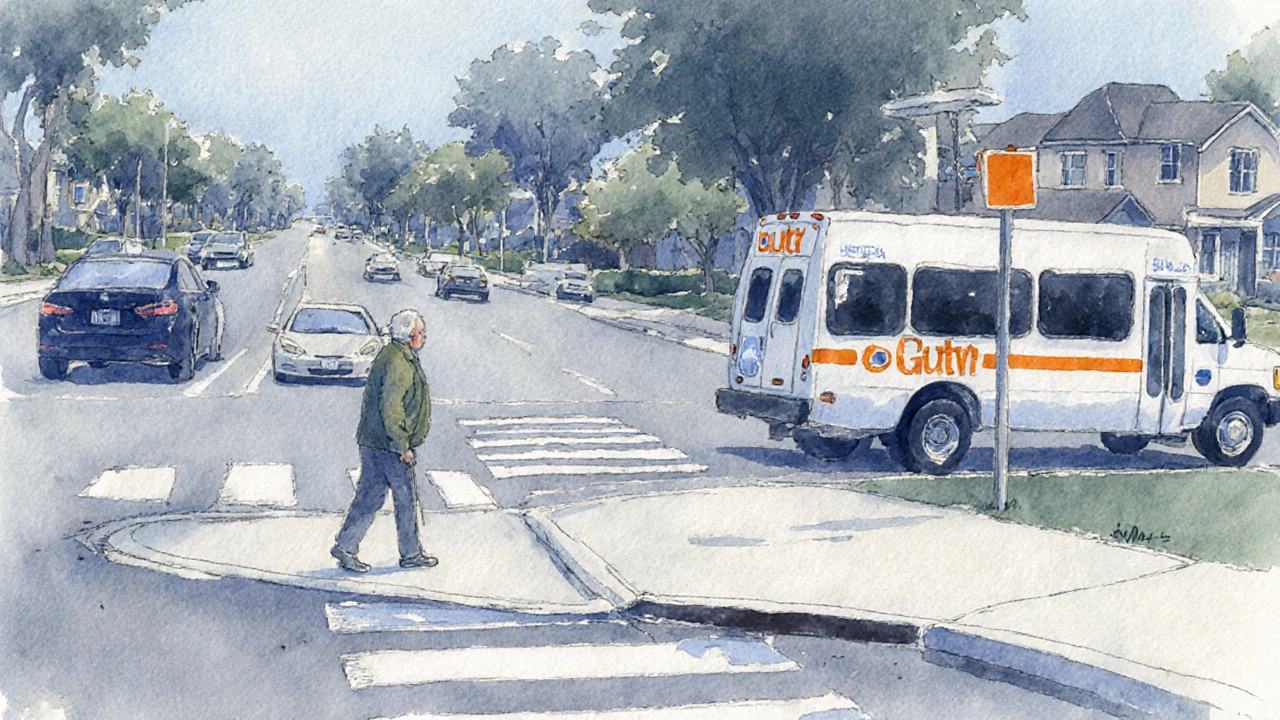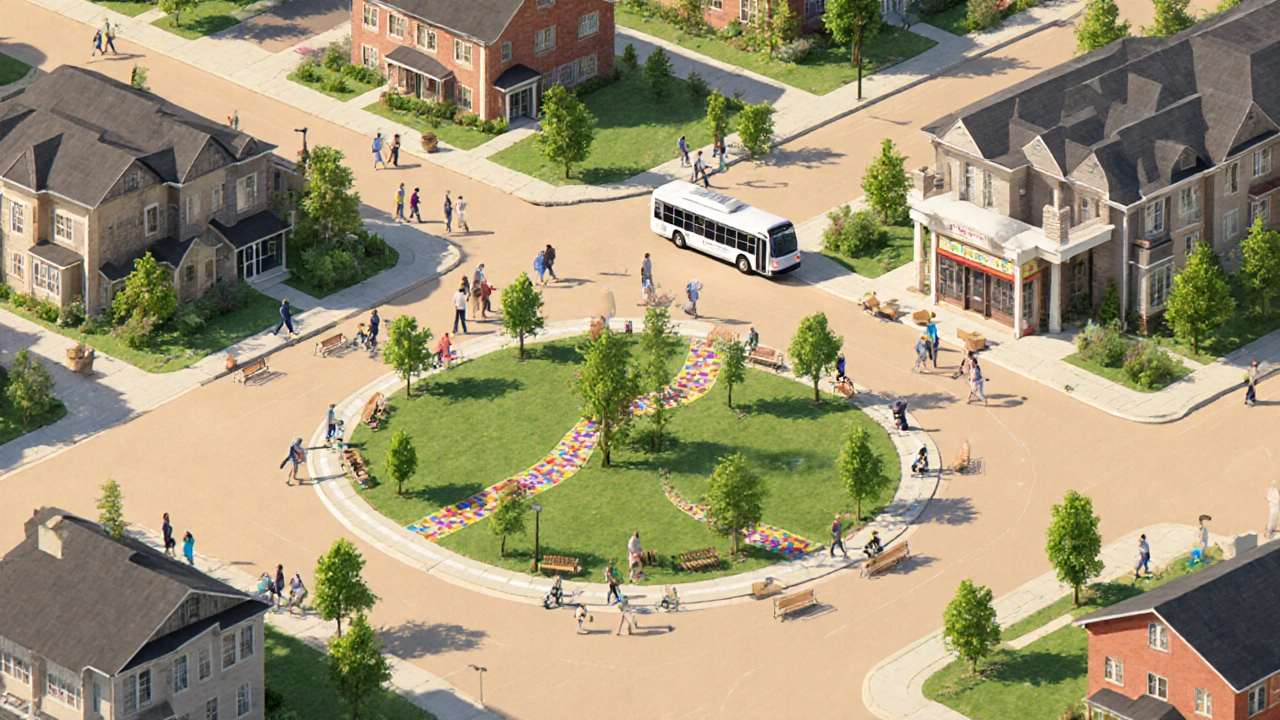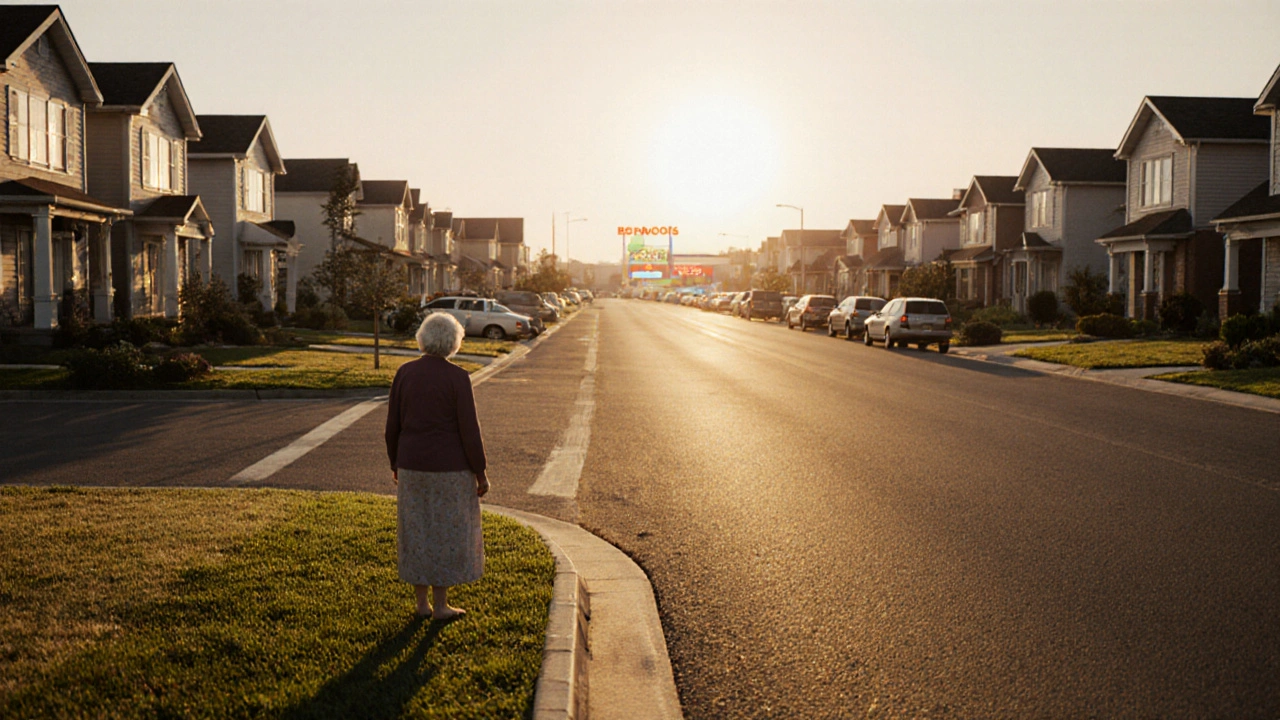Senior-Friendly Neighborhood Impact Calculator
This calculator estimates how different neighborhood characteristics affect senior well-being. Adjust the sliders to see how changes in key factors impact quality of life for older adults.
Estimated Impact
Recommendations
Average Distance: 1.8 miles
Walkability: 42/100
Transit: 4 trips/day
Isolation: 34%
Response Time: 9 minutes
Average Distance: 0.3 miles
Walkability: 78/100
Transit: 18 trips/day
Isolation: 12%
Response Time: 5 minutes
Walkability: 42/100
Transit: 4 trips/day
Distance: 1.8 miles
Isolation: 34%
Response Time: 9 minutes
Imagine a quiet suburb where houses sit far apart, streets are wide, and cars dominate the landscape. Low density living is a settlement pattern that spreads homes and amenities across large land areas, often prioritizing private space over shared services. For many families this feels like the ideal lifestyle, but for the aging population it can create unexpected challenges that ripple through senior care systems.
Why low density matters for older adults
Older adults rely heavily on proximity. A study by the National Institute on Aging in 2023 showed that seniors living within a 0.5‑mile walkable radius to groceries, clinics, and social venues reported 30% fewer falls and 22% lower rates of depression compared to those farther away. When homes are scattered, the distance to essential services grows, making daily tasks harder and increasing dependence on cars or public transport.
Key factors that shape the senior experience
- Walkability: Walkability measures how easy it is to navigate a neighborhood on foot. Low density areas often score low on sidewalk continuity, crossing safety, and destination density.
- Social isolation: Social isolation rises when neighbors are few and community hubs are distant. Loneliness is linked to a 50% higher risk of heart disease in seniors.
- Healthcare access: Healthcare access declines as travel time to primary care clinics exceeds 30minutes, a common reality in sprawling suburbs.
- Transportation options: Transportation services, such as demand‑responsive shuttles, are less frequent in low‑density zones, leaving many seniors stranded.
- Housing affordability: While larger homes may seem affordable, the cumulative cost of car ownership, fuel, and maintenance can outweigh any savings, especially on fixed incomes.

How community design can mitigate risks
Design isn’t just about aesthetics; it can actively protect health. Community design that incorporates mixed‑use zoning, pocket parks, and senior‑friendly transit hubs can shrink the distance between home and need.
Examples include:
- Creating 5‑minute walking loops around assisted‑living facilities.
- Integrating age‑friendly benches every 300feet along sidewalks.
- Offering shared‑mobility programs that allow seniors to book rides via a simple phone call.
Low vs. high density: A side‑by‑side look
| Factor | Low Density | High Density |
|---|---|---|
| Average distance to grocery store | 1.8miles | 0.3miles |
| Walkability score (0‑100) | 42 | 78 |
| Public transit frequency (trips per day) | 4 | 18 |
| Reported feelings of isolation (%) | 34 | 12 |
| Average emergency response time | 9minutes | 5minutes |
These numbers aren’t just statistics; they translate into real‑world outcomes-fewer trips to the doctor, lower medication costs, and a higher chance of aging in place.
Policy levers that can reshape the landscape
Governments can nudge development toward senior‑friendly models without forcing anyone to abandon their preferred lifestyle. Some effective tools:
- Zoning incentives: Offer density bonuses to developers who include affordable senior units and ground‑level services.
- Transit funding: Prioritize flexible bus routes that link low‑density neighborhoods to major health centers.
- Home‑modification grants: Help older homeowners retrofit entrances, add grab bars, and install smart‑doorbells, reducing reliance on external services.

Practical steps for seniors and their families
If you or a loved one already lives in a spread‑out suburb, you don’t have to wait for policy change. Here’s a checklist to boost safety and well‑being:
- Map out essential destinations (pharmacy, clinic, grocery) and note travel times.
- Explore local senior‑center programs; many offer shuttle rides on Tuesdays and Thursdays.
- Invest in a personal emergency response system (PERS) that connects to nearby caregivers.
- Join a neighborhood watch or volunteer group to build social ties and reduce isolation.
- Consider “aging‑in‑place” home upgrades that make daily chores easier.
Key Takeaways
- Low density living stretches distances to health services, increasing risks for older adults.
- Walkability, social connectivity, and reliable transport are the three pillars of senior‑friendly neighborhoods.
- Community design that blends housing with everyday services can offset many of the downsides of sprawling suburbs.
- Policy incentives, such as zoning bonuses and transit funding, are proven levers for creating age‑inclusive environments.
- Families can proactively improve safety by mapping resources, using technology, and fostering local connections.
Frequently Asked Questions
How does low density affect emergency response times for seniors?
Emergency services travel farther between calls in spread‑out neighborhoods, which can add 3‑5 minutes to response times. Those extra minutes significantly raise the risk of severe outcomes after falls or cardiac events.
Can public transit really work in a low‑density suburb?
Yes, but it needs a flexible model. Demand‑responsive shuttles, paratransit services, and ride‑share partnerships can provide door‑to‑door coverage without the cost of fixed‑route buses.
What home modifications are most useful for seniors in sprawling areas?
Key upgrades include lever‑style handles, non‑slip flooring, stairlifts, and smart lighting that turns on automatically. Adding a video‑doorbell also reduces the need to walk to the front door for deliveries.
Are there any examples of suburbs successfully retrofitting for seniors?
The town of Brookfield, Illinois introduced a "Senior Village" program in 2021. By converting underused parking lots into pocket parks and adding weekly shuttle routes, they reduced senior isolation scores by 40% within two years.
How can families assess whether a low‑density home is suitable for an aging parent?
Start with a travel‑time audit: count minutes to medical clinics, grocery stores, and community centers. Then evaluate the property’s curb‑cut access, stair presence, and proximity to any senior‑oriented services. If the audit reveals multiple barriers, consider a retrofit plan or relocation to a more walkable pocket.


Comments (7)
Ajay Kumar
October 6, 2025 AT 13:23Living in a low‑density suburb can feel peaceful, but for seniors it often means longer walks to the corner store. I’ve seen my own grandma struggle with that extra mile, especially after a rainy afternoon. When sidewalks are sparse, the risk of a slip or fall climbs dramatically. It’s also harder to pop over for a quick chat, which can leave older neighbors feeling cut off. Simple tweaks like a nearby bench or a community shuttle can make a world of difference.
Richa Ajrekar
October 16, 2025 AT 23:23Your article is full of vague statements and the data citations are missing. Please proofread before publishing.
Pramod Hingmang
October 27, 2025 AT 09:23Totally get it-sprawling streets turn simple trips into mini‑marathons, and the scenery can feel endless yet lonely.
Benjamin Hamel
November 6, 2025 AT 19:23Low‑density neighborhoods certainly offer quiet streets and larger yards, which many people find appealing. However, for seniors the trade‑off often includes longer distances to essential services. When a grocery store sits nearly two miles away, the extra drive or walk can deter frequent trips. This can lead to less fresh food consumption and greater reliance on delivery fees. In addition, the spacing of houses means fewer neighbors nearby to check in on each other. Social isolation, as the article notes, correlates with higher rates of depression and even heart disease. Emergency response times also suffer because ambulances must cover more ground. A study I read showed that response times can be three to five minutes longer in sprawling suburbs. Those minutes can be the difference between a full recovery and a permanent disability after a fall. Public transit options are typically sparse, making it harder for seniors without a car to attend appointments. Even when demand‑responsive shuttles exist, the scheduling windows can be inconvenient. On the bright side, planners can mitigate these issues by integrating mixed‑use zones. Adding pocket parks and senior‑friendly benches every few hundred feet encourages short walks. Implementing shared‑mobility services that can be booked by phone removes the tech barrier for many older adults. Ultimately, thoughtful design can preserve the serenity of low‑density living while protecting senior health.
Christian James Wood
November 17, 2025 AT 05:23While it's true that sprawl adds miles, many seniors actually prefer the peace and space it provides, and not every extra step translates to a health crisis.
Rebecca Ebstein
November 27, 2025 AT 15:23Great post! I think tiny changes like community gardens can really boost mood for older folks.
Artie Alex
December 8, 2025 AT 01:23Your assertion posits a partial optimization of senior well‑being predicated on environmental tranquility; however, extant epidemiological models demonstrate a statistically significant inverse correlation between residential density gradients and geriatric morbidity indices, thereby necessitating a multifactorial intervention framework.